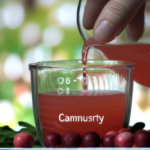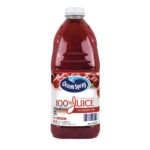Juice Tips and Tricks
How Many Carbs Are In Cranberry Juice

As someone who enjoys drinking cranberry juice, I have often wondered about its nutritional value. I am particularly interested in the amount of carbohydrates in cranberry juice. Since carbohydrates are important for our diet, knowing how much we are consuming is essential.
Cranberry juice is often touted for its health benefits, including its ability to prevent urinary tract infections and promote heart health. However, as with any food or beverage, it’s important to understand the nutritional content before incorporating it into your diet.
In this article, I’ll explore the number of carbs in cranberry juice, as well as the potential benefits and drawbacks of consuming it.
Key Takeaways
- The amount of carbohydrates in cranberry juice varies depending on the brand and type, but on average, one cup contains around 30 grams of carbs.
- Low-carb alternatives to cranberry juice include unsweetened almond/coconut milk and herbal teas.
- Sugar-free or low-sugar options are better for those watching their carb/sugar intake.
- It’s important to make dietary changes under the guidance of a healthcare professional.
What is Cranberry Juice?
So, you’re probably wondering what cranberry juice actually is, right? It’s a delicious beverage made from the tart and tangy cranberry fruit, often enjoyed as a refreshing drink or used as a mixer in cocktails.
Cranberries are native to North America and have been used for centuries by Native Americans for their medicinal properties. Today, cranberry juice is popular all over the world and is used in various ways, from treating urinary tract infections to preventing gum disease.
Aside from its unique taste, cranberry juice is also known for its health benefits. It’s a rich source of antioxidants, which help protect the body against free radicals that can cause cellular damage. Cranberry juice is also believed to have anti-inflammatory properties, which can help reduce the risk of chronic diseases such as heart disease and cancer.
So, with all these benefits, it’s no wonder that cranberry juice is a popular choice for health-conscious individuals. Speaking of health, let’s talk about how many carbs are in cranberry juice.
Carbohydrates in Cranberry Juice
I’m going to talk about the amount and types of carbohydrates in cranberry juice. Cranberry juice is known for its tart taste and many health benefits, but it’s important to know that it also contains carbohydrates.
Specifically, cranberry juice contains both simple and complex carbohydrates, which can impact blood sugar levels differently. Understanding the amount and types of carbohydrates in cranberry juice can help you make informed choices about incorporating it into your diet.
Types of Carbohydrates in Cranberry Juice
There’s no denying that the carbohydrate composition of cranberry juice is unique and can have a significant impact on your overall health and wellness.
Cranberry juice contains several types of carbohydrates, including fructose, glucose, and sucrose. These carbohydrates are responsible for the sweet taste of cranberry juice and contribute to its glycemic response.
The glycemic response is a measure of how quickly carbohydrates are digested, absorbed, and converted into glucose in the bloodstream. Cranberry juice has a low glycemic index, meaning that its carbohydrates are slowly absorbed and do not cause a rapid increase in blood sugar levels.
This makes cranberry juice a great option for those with diabetes or anyone looking to maintain stable blood sugar levels throughout the day. However, it’s important to note that the amount of carbohydrates in cranberry juice can vary depending on the brand and serving size, which we’ll explore in the next section.
Amount of Carbohydrates in Cranberry Juice
You simply won’t believe how much of an impact the amount of carbohydrates in your favorite brand of cranberry juice can have on your health goals.
When it comes to cranberry juice, the amount of carbohydrates can vary greatly depending on the brand and type. For example, sweetened cranberry juice cocktail can have up to 30 grams of carbohydrates per 8-ounce serving, while unsweetened cranberry juice may only have around 5 grams. This carb count comparison is important to consider if you’re trying to manage your blood sugar or control your calorie intake.
In addition to the carb count, it’s important to remember that cranberry juice is also a great source of hydration. Drinking enough water is important for overall health and can also help with weight management.
So, while it’s important to be mindful of the amount of carbohydrates in your cranberry juice, don’t forget about the benefits of staying hydrated. With that said, let’s dive into the benefits of cranberry juice and how it can support your health goals.
Benefits of Cranberry Juice
I’m excited to discuss the benefits of cranberry juice, which has been shown to have some impressive health benefits.
Firstly, cranberry juice is known for its ability to prevent urinary tract infections due to its high levels of proanthocyanidins that prevent bacteria from adhering to the urinary tract lining.
Additionally, cranberry juice is rich in antioxidants that help to protect the body from free radical damage.
Finally, drinking cranberry juice can also improve digestive health by promoting the growth of beneficial gut bacteria.
Urinary Tract Infection Prevention
Drinking cranberry juice regularly can help prevent urinary tract infections. UTIs are commonly caused by bacteria like E. coli that attach to the walls of the urinary tract, causing inflammation and discomfort. Cranberry juice contains compounds called proanthocyanidins that prevent the bacteria from adhering to the urinary tract walls, thereby reducing the risk of infection. Natural remedies and lifestyle changes, like staying hydrated and avoiding irritating feminine products, can also help prevent UTIs.
While cranberry juice is a popular home remedy for UTI prevention, its effectiveness and safety have been debated. Some studies suggest that cranberry supplements may be more effective than juice, as they contain a higher concentration of proanthocyanidins. However, it’s essential to note that supplements are not regulated by the FDA, and their safety and efficacy are not always guaranteed. It’s crucial to speak with a healthcare provider before starting any supplement regimen, especially if you have underlying health conditions or are taking medications.
Cranberry juice’s antioxidant properties make it a popular choice for those looking to improve their urinary tract health. However, it’s essential to consider all factors, including potential risks and benefits, before deciding to make it a regular part of your routine. In the next section, we’ll explore cranberry juice’s antioxidant properties and how they can benefit overall health.
Antioxidant Properties
The antioxidant properties of cranberry juice have been researched for their potential health benefits. Here are some of the benefits that have been found:
- Cranberry juice is high in antioxidants, which can help protect the body from damage caused by free radicals.
- Antioxidants in cranberry juice may help reduce inflammation in the body, which can lead to a variety of health problems.
- Some studies have suggested that cranberry juice may help improve heart health by reducing blood pressure and cholesterol levels.
- Cranberry juice may also have anti-cancer properties, although more research is needed to confirm this.
While there are many potential antioxidant benefits to drinking cranberry juice, there are also some potential drawbacks to consider. For example, cranberry juice is often high in sugar, which can contribute to weight gain and other health problems. Additionally, some people may experience digestive issues after drinking cranberry juice, such as bloating or diarrhea. Despite these potential drawbacks, many people find that drinking cranberry juice in moderation can be a healthy addition to their diet.
Moving on to the next section about digestive health improvement, it’s important to note that cranberry juice may also have some benefits in this area.
Digestive Health Improvement
One potential benefit of consuming cranberry juice is its ability to improve digestive health. Cranberry juice contains compounds that have probiotic benefits and can improve the health of the gut microbiome. The gut microbiome is a collection of microorganisms that live in the digestive tract and play a crucial role in maintaining overall health.
When the gut microbiome is healthy, it can help to prevent digestive issues such as bloating, constipation, and diarrhea. Research has shown that consuming cranberry juice can increase the number of beneficial bacteria in the gut, which can lead to improved digestive health. The probiotic benefits of cranberry juice are due to its high levels of polyphenols, which are compounds that have been shown to have anti-inflammatory and antioxidant properties.
These properties can help to reduce inflammation in the gut and promote the growth of beneficial bacteria. Overall, incorporating cranberry juice into your diet can be a simple and effective way to improve your digestive health.
Moving on to the next section about cranberry juice and blood sugar, it’s important to note that consuming too much cranberry juice can actually have negative effects on blood sugar levels.
Cranberry Juice and Blood Sugar
When it comes to managing my blood sugar levels, I always try to be mindful of what I consume. That’s why I was curious to learn about the effects of cranberry juice on blood sugar.
After doing some research, I discovered that cranberry juice has a low glycemic index, meaning it’s unlikely to cause a rapid spike in blood sugar levels. This makes it a potentially beneficial drink option for those with diabetes or anyone looking to maintain stable blood sugar levels.
Effect on Blood Sugar Levels
If you’re watching your blood sugar levels, you’ll want to know that cranberry juice can cause a spike in glucose due to its high carbohydrate content. Carbohydrates are broken down into glucose in the body, which then enters the bloodstream and causes blood sugar levels to rise. Cranberry juice contains around 30 grams of carbohydrates per cup, which is a significant amount for those who are trying to manage their blood sugar levels.
To give you a better idea of how cranberry juice affects blood sugar levels, here’s a table comparing the carbohydrate content and glycemic index of different types of cranberry juice:
| Type of Cranberry Juice | Carbohydrate Content (per cup) | Glycemic Index |
|---|---|---|
| Unsweetened | 12 grams | 50 |
| Sweetened | 30 grams | 68 |
| Cranberry Juice Cocktail | 30 grams | 68-70 |
As you can see from the table, sweetened cranberry juice and cranberry juice cocktail have a higher glycemic index compared to unsweetened cranberry juice. This means that they can cause a faster and more significant rise in blood sugar levels. However, it’s important to note that the glycemic index of a food doesn’t always reflect how it affects blood sugar levels in real-life situations, since it doesn’t take into account other factors that can affect insulin response. In the next section, we’ll discuss the glycemic index of cranberry juice in more detail.
Glycemic Index of Cranberry Juice
Explore how easily your body can convert the carbohydrates in cranberry juice into glucose by looking at its glycemic index. The glycemic index (GI) measures how quickly a food raises blood glucose levels. A high GI indicates a rapid and significant increase in blood sugar levels, while a low GI indicates a slower and more gradual rise.
The GI of cranberry juice is relatively low, around 50. This means that it is unlikely to cause a sudden spike in blood sugar levels, which is good news for people who need to manage their blood sugar levels, such as those with diabetes.
In addition to its favorable glycemic response, cranberry juice has several other benefits. It is rich in antioxidants, which can help protect against cell damage and inflammation. It also contains vitamin C, which supports immune function, and proanthocyanidins, which may help prevent urinary tract infections.
Incorporating cranberry juice into your diet can be a nutritious and delicious way to support overall health.
As we move into the subsequent section about cranberry juice and low-carb diets, it’s worth noting that while cranberry juice does contain carbohydrates, there are ways to incorporate it into a low-carb diet. By choosing unsweetened varieties or diluting it with water, you can enjoy the benefits of cranberry juice without consuming excessive amounts of carbohydrates.
Cranberry Juice and Low-Carb Diets
Although cranberry juice can be a healthy beverage choice, those following a low-carb diet should be mindful of the carb content. While cranberry juice contains many health benefits, it also contains a significant amount of carbs.
One cup of cranberry juice contains around 30 grams of carbs, making it a less than ideal choice for those trying to limit their carb intake. Low-carb alternatives to cranberry juice include unsweetened almond milk, unsweetened coconut milk, and herbal teas. These options are low in carbs and can be enjoyed as a refreshing alternative to cranberry juice.
It’s also important to consider the sugar content of cranberry juice, as many brands add additional sugar to enhance the taste. Opting for a sugar-free or low-sugar cranberry juice is a better option for those watching their carb and sugar intake.
When it comes to managing blood sugar levels, monitoring carb and sugar intake is crucial. In the next section, we’ll explore how cranberry juice can impact blood sugar levels and its potential benefits for those with diabetes.
Cranberry Juice and Diabetes
To manage your diabetes, you’ll be interested to know the potential benefits of drinking cranberry juice. Here are three important facts to consider:
-
Cranberry juice has been shown to improve insulin resistance in people with type 2 diabetes. Insulin resistance occurs when the body’s cells don’t respond properly to insulin, leading to high blood sugar levels. By improving insulin resistance, cranberry juice may help improve glycemic control in people with diabetes.
-
A study found that drinking cranberry juice daily for eight weeks significantly reduced fasting blood sugar levels in people with type 2 diabetes. This suggests that cranberry juice may be a useful addition to a diabetes management plan.
-
Cranberry juice contains antioxidants called proanthocyanidins, which have been shown to have anti-inflammatory effects. This is important because inflammation is thought to play a role in the development and progression of diabetes.
Incorporating cranberry juice into your diabetes management plan may have potential benefits for improving insulin resistance and glycemic control. In the next section, we’ll discuss how cranberry juice can also contribute to weight loss.
Cranberry Juice and Weight Loss
I’ve been looking into the potential benefits of cranberry juice for weight loss. One key factor to consider is the calorie content of cranberry juice. While it can vary depending on the brand and type, most cranberry juices have around 120 calories per 8-ounce serving.
However, some studies suggest that cranberry juice may play a role in weight loss by increasing feelings of fullness and reducing overall calorie intake.
Calorie Content of Cranberry Juice
You’ll be happy to know that cranberry juice typically contains around 30-40 calories per 8-ounce serving. This makes it a relatively low-calorie beverage option for those who are calorie counting.
However, it’s important to note that not all cranberry juices are created equal in terms of nutritional value. Some brands may contain added sugars or preservatives, which can increase the overall calorie count and decrease its nutritional value.
To ensure that you’re getting the most out of your cranberry juice, it’s important to read the nutrition label and choose a brand that’s made with 100% pure cranberry juice and without any added sugars or preservatives.
Additionally, it’s important to remember that while cranberry juice can be a healthy addition to your diet, it shouldn’t be relied upon as the sole solution for weight loss.
In the next section, we’ll explore the role of cranberry juice in weight loss and how it can be incorporated into a healthy and balanced diet.
Role of Cranberry Juice in Weight Loss
You might be surprised to learn that cranberry juice consumption can actually aid in shedding a few extra pounds. Cranberry juice has weight loss benefits due to its high concentration of antioxidants and low calorie content. Antioxidants help prevent damage to the body’s cells and reduce inflammation, which can contribute to weight gain.
Additionally, cranberry juice is a low calorie beverage, with only 45 calories per cup, making it a great alternative to high calorie drinks like soda and juice cocktails. But it’s important to note that cranberry juice alone won’t cause significant weight loss. It should be incorporated into a healthy and balanced diet, along with regular exercise.
While cranberry juice is a great addition to any weight loss plan, it shouldn’t be relied on as a quick fix for shedding pounds. However, the benefits of cranberry juice consumption extend beyond weight loss, including its positive impact on heart health.
Cranberry Juice and Heart Health
Cranberry juice is a delicious way to promote heart health with its ability to lower cholesterol levels and reduce the risk of heart disease. The polyphenols and flavonoids found in cranberries are known to have strong antioxidant properties, which can help prevent the oxidation of LDL cholesterol and reduce inflammation in the arteries. As a result, drinking cranberry juice regularly can lower the risk of developing heart disease, particularly in women.
To better understand the cardiovascular benefits of cranberry juice, let’s take a look at the following table:
| Cardiovascular Benefits of Cranberry Juice | Description | Mechanism |
|---|---|---|
| Reduces LDL Cholesterol | Cranberry juice contains antioxidants that prevent the oxidation of LDL cholesterol, which can lead to plaque buildup in the arteries. | Antioxidant properties |
| Lowers Blood Pressure | The polyphenols in cranberries can help relax blood vessels, allowing for better blood flow and lower blood pressure. | Vasodilation |
| Prevents Blood Clots | Cranberry juice can help prevent blood clots, which can cause heart attacks and strokes, by inhibiting platelet aggregation. | Antiplatelet activity |
| Reduces Inflammation | The flavonoids in cranberries can help reduce inflammation in the arteries, which is a major risk factor for heart disease. | Anti-inflammatory properties |
As you can see, cranberry juice has a number of heart-healthy benefits that make it a great addition to any diet. However, its benefits go beyond just cardiovascular health. Let’s explore how cranberry juice can support overall health in the next section.
Cranberry Juice and Overall Health
Did you know that consuming a moderate amount of cranberry juice has been linked to a 25% reduction in the risk of urinary tract infections? This is because cranberries contain compounds called proanthocyanidins, which can prevent bacteria from sticking to the walls of the urinary tract. However, it’s important to note that cranberry juice isn’t a cure for urinary tract infections and shouldn’t be used as a substitute for medical treatment.
Aside from its potential benefits for urinary tract health, cranberry juice has also been linked to other health benefits. For example, it may help to lower the risk of cardiovascular disease due to its anti-inflammatory properties. However, it’s important to choose a cranberry juice that’s low in added sugars and calories.
If you’re looking for alternative options, you may consider incorporating fresh cranberries into your diet or taking cranberry supplements. As with any dietary changes, it’s always a good idea to consult with a healthcare professional before making any significant changes to your diet.
Frequently Asked Questions
Can cranberry juice be consumed by people with a history of kidney stones or other urinary tract issues?
As someone with a history of kidney stones or UTIs, I have found that consuming cranberry supplements can be helpful in managing UTIs. However, it is important to consult with a healthcare provider before starting any new supplement regimen.
Is there a difference in carb content between fresh cranberry juice and store-bought varieties?
Comparing fresh and store-bought cranberry juice, nutritional value and taste may differ. For those with diabetes, it’s important to consider the impact and benefits of cranberry juice, while taking precautions.
What is the recommended daily intake of cranberry juice to reap its health benefits?
To reap the health benefits of cranberry juice, I recommend incorporating it into your daily diet by drinking 8-16 ounces per day. Cranberry juice may aid in weight loss and management due to its low calorie content and high antioxidant levels.
Are there any potential side effects of consuming cranberry juice regularly?
While regular consumption of cranberry juice has potential health benefits, it’s important to note that there are also potential risks and long-term effects. These include possible stomach discomfort and increased risk of kidney stones.
How does the carb content of cranberry juice compare to other popular fruit juices?
When it comes to juice comparisons and carb sources, cranberry juice is relatively low in carbs compared to other popular fruit juices. However, it’s important to consider the added sugars and overall nutritional value as well.
Conclusion
In conclusion, cranberry juice is a delicious and nutritious beverage that’s packed with health benefits. The amount of carbohydrates in cranberry juice varies depending on the brand and type. However, most cranberry juice contains around 30 grams of carbohydrates per 8-ounce serving. This can be a considerable amount for individuals who are monitoring their carb intake, especially those following low-carb diets. It’s important to check the label to ensure the carb content in cranberry juice aligns with your dietary goals. Opting for low-sugar or unsweetened varieties can help reduce the overall carbohydrate load while still allowing you to enjoy the benefits of this refreshing drink.
Despite the carbohydrate content, cranberry juice can still be a part of a healthy diet. This is especially true for those looking to boost their heart health, manage their blood sugar levels, or lose weight. Overall, cranberry juice is an excellent source of antioxidants, vitamins, and minerals that can support your overall health and well-being.
Drinking cranberry juice regularly may help you maintain healthy blood pressure levels, promote healthy digestion, and even reduce your risk of chronic diseases like heart disease and diabetes. So, if you’re looking for a delicious and nutritious beverage to add to your diet, give cranberry juice a try! Trust me, it’s like a burst of vibrant flavor in every sip.
Susannah expertise lies in researching and compiling evidence-based content on juicing, nutrition, and overall health. She is committed to ensuring that The Juicery World offers accurate, up-to-date, and trustworthy information to empower readers to take control of their health. Susannah’s goal is to inspire individuals to embrace juicing as a way to nourish their bodies and live their best lives.
Juice Tips and Tricks
How To Juice A Lime In A Juicer

I absolutely adore including lime juice in my meals and drinks, however manually squeezing them can be quite a hassle. That’s why I made the decision to invest in a juicer to simplify, hasten, and streamline the process. After conducting some research, I stumbled upon a compact juicer that is ideal for effortlessly extracting the juice without much hassle. Additionally, I discovered that the carb content in lime juice is remarkably low, allowing me to incorporate it into my recipes without concern about unnecessary carbs. Now, I can effortlessly elevate the taste of my dishes with fresh lime juice whenever I desire!
In this article, I’ll walk you through the steps on how to juice a lime in a juicer, from selecting the right juicer to troubleshooting common issues.
Firstly, it’s important to choose a juicer that’s suitable for citrus fruits. Look for a model with a cone-shaped attachment specifically designed for squeezing lemons, limes, and oranges.
Next, choose limes that are firm and heavy for their size, with bright green skin and no soft spots. Rinse them under cold water and pat them dry before cutting them in half.
With these simple steps, you’re ready to start juicing!
Key Takeaways
- Investing in a juicer with a cone-shaped attachment for citrus fruits makes juicing quick and effortless.
- Look for firm, heavy limes with bright green skin and no soft spots for maximum juice extraction.
- Apply firm pressure while juicing and roll limes on a hard surface before cutting to release more juice.
- Fresh lime juice is a popular ingredient in many recipes, including cocktails, marinades, dressings, and limeade.
Choose the Right Juicer
To get the most juice out of your lime, you’ll want to make sure you’ve got the right juicer on hand! There are different types of juicers, but for citrus fruits like limes, you’ll want to use a manual or electric citrus juicer.
These juicers are specifically designed to extract the maximum amount of juice from citrus fruits.
When using a citrus juicer, it’s important to cut the lime in half and place it cut side down on the reamer. Apply pressure and twist the lime back and forth to release the juice.
With an electric citrus juicer, simply place the lime half on the reamer and press the lever down to extract the juice. The key is to press firmly, but not too hard as to avoid bitterness from the pith.
With the right juicer and proper technique, you’ll get the most juice out of your limes in no time!
Now, let’s move on to the next step and select and prepare your limes.
Select and Prepare Your Limes
First things first, you might be thinking that selecting and preparing limes is a hassle, but trust me, it’s worth it for the delicious flavor it’ll add to your drink.
When selecting limes, look for ones that are firm and heavy for their size, with smooth and shiny skin. Avoid limes with soft spots or blemishes, as they may be overripe and not as flavorful.
It’s also important to properly store your limes before juicing them. Keep them in a cool, dry place away from direct sunlight, and avoid storing them with other citrus fruits as they can cause each other to spoil faster.
By selecting and storing your limes correctly, you’ll ensure that the juice you get from them is of the highest quality.
Now that you’ve got your limes, it’s time to set up your juicer and start juicing!
Set Up Your Juicer
Once you have your firm and heavy limes with smooth and shiny skin, it’s time to get your juicer ready for action.
Juicing a lime in a juicer is a simple process, but it requires some knowledge of juicing techniques and types of juicers. There are different types of juicers available in the market, such as centrifugal juicers, masticating juicers, and citrus juicers. For juicing limes, you need a citrus juicer that’s specifically designed for extracting juice from citrus fruits.
To set up your juicer, plug it in and place the container underneath the spout. Then, position the lime half on the juicer’s cone with the cut side facing down. Gently press the lime down onto the cone and turn it clockwise to extract the juice. You can also tilt the lime slightly or rotate it back and forth to ensure maximum juice extraction.
Once you have extracted the juice, remove the lime half and repeat the process with the remaining limes.
Juicing your limes is an important step in preparing your recipe. To ensure the best flavor and quality, it’s recommended to use fresh and ripe limes. Juicing your limes using a juicer is an easy and efficient way to extract the juice without any mess or hassle.
Now that your juicer’s set up, let’s move on to the next section about how to juice your limes to get the most out of them.
Juice Your Limes
When preparing a recipe that calls for lime juice, it’s important to note that one medium lime yields approximately 2 tablespoons of juice. Fresh lime juice is a popular ingredient in many recipes, including marinades, dressings, cocktails, and desserts. Lime juice not only adds a tangy flavor to your dish, but it also provides a significant amount of vitamin C, which can boost your immune system and improve your skin health.
To juice your limes, first cut them in half using a sharp knife. Then place each half on the juicing cone of your juicer, cut side down. Turn the juicer on and press the lime down with a little force, moving it back and forth to extract all the juice. Repeat with the remaining limes until you have the desired amount of juice for your recipe. Once you’ve juiced all your limes, strain the juice to remove any pulp or seeds if you prefer a smoother consistency. Now that you know *how to make lime juice*, you can use it in a variety of drinks, marinades, or recipes that call for a tangy, citrusy flavor. Freshly squeezed lime juice adds a vibrant touch to any dish, enhancing its overall taste.
Collect the juice by pouring it into a measuring cup or a small bowl.
Collect the Juice
When I collect lime juice, I always use a measuring cup or bowl to ensure accuracy. This is important because the amount of lime juice needed can greatly affect the taste of the dish.
After juicing the limes, I strain the juice to remove any pulp or seeds. This results in a smooth and flavorful juice.
Use a Measuring Cup or Bowl
Using a measuring cup or bowl can save you time and frustration when juicing a lime in a juicer, so give it a try! Here are some measuring techniques that can help you get the most juice out of your lime:
- Cut the lime in half crosswise, so you can easily extract the juice from both halves.
- Hold the lime half over the measuring cup or bowl, cut-side down, and squeeze it firmly with your hand.
- Use a spoon to scrape out any remaining juice and pulp from the lime half.
- Repeat with the other half of the lime.
Using a measuring cup or bowl also helps you choose the right lime variety for your recipe, as you can measure the exact amount of juice you need. Whether you’re using a Persian or a Key lime, make sure it’s fresh and ripe for the best flavor.
Now that you’ve collected your lime juice, it’s time to strain it to remove any pulp or seeds.
Let’s move on to the next step: strain the juice.
Strain the Juice
Now that you’ve got your freshly squeezed lime nectar, it’s time to give it a proper strain to ensure a smooth and pulp-free experience. To do this, I recommend using a strainer for lime juice. You can use a fine mesh strainer or a cheesecloth to get rid of any leftover pulp or seeds.
Pour the freshly squeezed lime juice through the strainer and into a measuring cup or bowl. Use a spoon or spatula to press down on the pulp and extract as much juice as possible. The result should be a perfectly smooth and refreshing lime juice that’s perfect for cocktail making.
To take this up a notch, you can add a few drops of mint extract or a splash of sparkling water to the lime juice for a fun twist on a classic drink.
Now that you have your strained and perfectly fresh lime juice, it’s time to store it properly to ensure it stays fresh for as long as possible.
Store the Juice
To get the most out of your lime juice, make sure to properly store it in an airtight container in the fridge. Here are a few things to keep in mind when storing lime juice:
- Use a glass or plastic container with a tight-fitting lid to prevent air from getting in and oxidizing the juice.
- Make sure the container is clean and dry before pouring in the juice.
- Label the container with the date you made the juice so you know when to use it by.
- Store the juice in the refrigerator for up to one week.
Properly storing lime juice will help preserve its freshness and flavor, making it a great addition to any recipe.
Once you’ve stored your juice, it’s important to clean your juicer to maintain its longevity and prevent any buildup.
Clean Your Juicer
Maintaining the longevity of your juicer is crucial, so it’s important to clean it properly after each use. To start, unplug the machine and disassemble the components.
Rinse the removable parts under running water and use a soft brush to scrub away any remaining pulp or residue. Be sure to pay extra attention to the small crevices where mold can grow.
For a deeper clean, mix a solution of water and white vinegar and soak the parts for 10-15 minutes before rinsing thoroughly. To prevent mold growth, make sure to dry each component completely before reassembling the juicer. Use a clean towel or let the parts air dry overnight.
Another cleaning tip is to avoid using harsh chemicals or abrasive materials that can damage the machine. Instead, opt for gentle cleaning solutions and soft brushes.
By following these cleaning tips, your juicer will continue to produce fresh, tasty juice for years to come.
Once your juicer is clean and ready to use, you may encounter some common issues such as clogged filters or unevenly extracted juice. Don’t worry, troubleshooting these problems is easier than you think. Simply refer to the next section for some helpful tips and tricks.
Troubleshoot Common Issues
So, I’ve been juicing for a while now and I’ve encountered a few common issues that might happen to you too. One of them is clogging or stalling of the juicer, which can be frustrating and time-consuming to deal with.
Another issue is low juice yield, which can be disappointing when you expect to get a lot of juice from your fruits and vegetables.
In this subtopic, we’ll discuss these issues and provide some troubleshooting tips to help you get the most out of your juicer.
Clogging or Stalling
If your juicer is clogging or stalling while juicing a lime, you may need to adjust the speed and push the lime through the chute with a little more force. To prevent clogs, make sure to remove any seeds or tough parts of the lime before juicing. Also, cut the lime into smaller pieces that can fit easily into the juicer.
Improving efficiency can also help prevent clogs and stalling. Try alternating between juicing a lime and then adding a piece of a softer fruit or vegetable, such as a cucumber or pear, to help push any remaining lime juice through the juicer.
Additionally, make sure to clean the juicer regularly to prevent any buildup of pulp or debris that can cause clogs. With these tips, you should be able to juice limes with ease and enjoy fresh, delicious lime juice in your recipes.
If you’re still experiencing issues, the next subtopic will cover low juice yield and how to address it.
Low Juice Yield
To get the most out of your lime, you’ll want to make some adjustments to your juicing technique. One common reason for low juice yield is using limes that aren’t ripe enough. It’s best to choose limes that’re fully ripe and have a slight give when gently squeezed. This’ll ensure that the lime is at its juiciest and ready to be used in your recipe.
Another technique for maximizing juice yield is to cut the lime in half crosswise, rather than lengthwise. This exposes more of the lime’s flesh to the juicer’s reamer, allowing for more juice to be extracted. Additionally, it’s important to apply firm pressure to the lime as it’s being juiced. This’ll help the juicer extract as much juice as possible.
With these adjustments, you’ll be able to get the most out of your lime and ensure that your recipe has the freshest and most vibrant flavor possible.
Now that you know how to adjust your juicing technique for the best yield, let’s explore some creative tips and variations to enhance the flavor and presentation of your lime juice.
Tips for Juicing Limes
When juicing limes, a helpful tip is to roll them on a hard surface before cutting them in half, similar to how a baker rolls dough to make it more pliable. This technique helps to break down the fibers and release more juice from the lime.
Another way to get the most out of your lime is to use a citrus reamer or a fork to extract the remaining juice from the pulp. By doing so, you can maximize the yield and ensure that you get the most juice from your lime.
When it comes to lime juice recipe ideas, there are plenty of creative options to choose from. You can add fresh lime juice to your favorite cocktails, marinades, dressings, or even use it to make a refreshing limeade.
One of my favorite ways to enjoy fresh lime juice is to mix it with honey and hot water for a soothing and immune-boosting tea. Whatever your preference may be, the key to a delicious lime juice is to use fresh, high-quality limes and to juice them properly.
Enjoy Your Fresh Lime Juice!
Now that you’ve learned some tips for juicing limes, it’s time to enjoy your fresh lime juice! There are so many benefits to drinking lime juice, from aiding digestion to boosting your immune system with its high vitamin C content. Plus, it’s a versatile ingredient that can be used in a variety of recipes, from cocktails to marinades.
To make the most of your fresh lime juice, here are some ideas to try:
- Make a classic margarita with tequila, lime juice, and a splash of orange liqueur.
- Mix lime juice with honey and hot water for a soothing morning drink.
- Add lime juice to your favorite salad dressing for a zesty kick.
- Make a marinade for grilled chicken or fish with lime juice, garlic, and olive oil.
- Stir lime juice into guacamole for a bright and tangy flavor.
So go ahead and juice those limes! With these simple ideas, you’ll be able to enjoy the benefits of lime juice in a variety of delicious ways.
Frequently Asked Questions
How long does freshly squeezed lime juice last in the fridge?
Freshly squeezed lime juice can last up to a week in the fridge. To extend its shelf life, store it in an airtight container and add a pinch of salt or a splash of vodka as preservative methods. Use within 3 days for best flavor.
Can you use a blender instead of a juicer to make lime juice?
Using a blender to juice citrus fruits is possible, but it will result in a thicker, pulpier consistency compared to using a juicer. For a smoother juice, use a juicer. However, adding a splash of sparkling water can make the thicker juice more enjoyable.
How many limes do you need to make a cup of lime juice?
To make a cup of lime juice, I use 8-10 limes. Lime juice ratios vary depending on personal preference, but I prefer a 1:1 ratio of lime juice to water. For the freshest flavor, I recommend hand juicing the limes using a citrus juicer or reamer.
Is it necessary to remove the peel before juicing the lime?
It’s not necessary to remove the peel before juicing a lime, but it can impact the flavor. The peel can add bitterness, so use a zester to add some of the peel’s essential oils for a brighter taste.
Can you use bottled lime juice instead of fresh lime juice in recipes?
While bottled lime juice is convenient, fresh lime juice offers superior flavor and health benefits. Look for limes that are heavy for their size, with smooth, shiny skin. Roll them on a hard surface before juicing to release more juice.
Conclusion
Well, there you have it, folks! Juicing limes in a juicer is a simple and easy process that can be done in no time. As someone who enjoys a good margarita, I can tell you that the quality and freshness of the lime juice you use can really make all the difference in the world.
It’s like a painter choosing the right colors for their canvas. Just as a painter carefully selects their colors, we must carefully choose our ingredients to create the perfect drink.
And with these tips and tricks, you can create a masterpiece of your own. So, go ahead and give it a try. Enjoy the refreshing taste of freshly squeezed lime juice in your favorite cocktail or dish.
Cheers to quality ingredients and delicious drinks!
Susannah expertise lies in researching and compiling evidence-based content on juicing, nutrition, and overall health. She is committed to ensuring that The Juicery World offers accurate, up-to-date, and trustworthy information to empower readers to take control of their health. Susannah’s goal is to inspire individuals to embrace juicing as a way to nourish their bodies and live their best lives.
Juice Tips and Tricks
How To Juice A Lime In An Electric Juicer
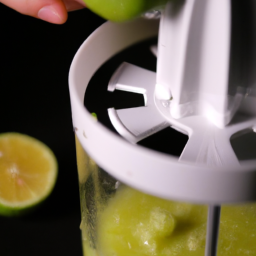
I absolutely adore adding freshly squeezed lime juice to my beverages and meals, but manually extracting it can be quite difficult. Fortunately, using an electric juicer simplifies the process significantly.
In this article, I will be sharing my step-by-step guide on how to juice a lime in an electric juicer.
First and foremost, it’s important to have the right equipment. A high-quality electric juicer will make the process much smoother and more efficient. With the right juicer, you’ll be able to extract the most juice possible from your limes, leaving you with a delicious and refreshing addition to your meals and beverages.
So, let’s dive into the details and learn how to use this handy kitchen gadget to juice a lime in no time!
Key Takeaways
- Using an electric juicer is the easiest and most efficient way to juice limes.
- High-quality electric juicers can extract the most juice possible from limes.
- Rolling limes on a flat surface before cutting them open can release more juice.
- Proper storage techniques are essential for preserving the quality and taste of lime juice.
Select the Right Equipment
Make sure you’ve got the right gear, like an electric juicer, to easily and efficiently juice your lime. Electric juicers are a great investment because they can make short work of juicing citrus fruits, and they’re easy to clean and maintain. They come in different sizes and prices, so choose one that suits your needs and budget.
Before using an electric juicer, make sure it’s clean and in good working condition. Follow the manufacturer’s instructions for cleaning and maintenance. If you don’t have an electric juicer, there are alternative juicing methods such as using a citrus reamer or a hand-held juicer. However, these methods may not be as efficient or as easy to use as an electric juicer.
Once you have your equipment ready, it’s time to choose high-quality limes to get the best flavor and juice extraction.
Choose High-Quality Limes
To get the most flavorful and zesty lime juice, it’s essential to start with fresh and high-quality limes. I highly recommend using organic limes, as they’re free from harmful pesticides and chemicals that can affect the taste of your juice. Organic limes also tend to be juicier and more flavorful compared to their non-organic counterparts.
When selecting your limes, look for ones that are firm and heavy for their size. They should also have a bright green color and feel slightly oily to the touch. To squeeze the most juice out of your limes, roll them firmly on a flat surface before cutting them open. This helps to break down the fibers and release the juice.
With these tips in mind, let’s move on to the next step of washing and prepping the limes for juicing.
Wash and Prep the Limes
First things first, you’ll want to give those limes a good scrub under cold water to remove any dirt or residue. Think of it like giving them a refreshing shower after a long day at the beach. You don’t want any dirt or bacteria ending up in your freshly squeezed lime juice.
Once they are clean, use a sharp knife to cut off the ends of the limes. This will make it easier for the juicer to extract the juice. When it comes to juicing limes, using organic limes is always a good option. Not only are they better for the environment, but they’re also free of harmful pesticides.
If you can’t find organic limes, try to choose limes that are ripe and have a bright green color. Avoid limes that are yellow or have any brown spots. By properly washing and prepping your limes, you’ll ensure that your juice is clean and free of any unwanted particles.
Now that your limes are prepped and ready to go, it’s time to start juicing.
Begin Juicing
Now it’s time for me to get my hands on those juicy limes and start extracting all that delicious citrus goodness.
First, I make sure that my electric juicer is plugged in and ready to use. Then, I cut the limes into halves and place them onto the juicer’s reamer.
I turn on the machine and let it work its magic, making sure to apply gentle pressure to the limes to ensure maximum juice extraction. There are different juicing techniques you can use depending on the type of juicer you have.
With electric juicers, the machine does most of the work for you, but you still need to make sure the limes are properly positioned and you’re applying enough pressure to extract all the juice. Lime juice benefits include being a great source of vitamin C and antioxidants, which can boost your immune system and help protect against disease.
With the juicing process complete, it’s time to move onto the next step and extract the juice from the machine’s container.
Extract the Juice
As the machine works its magic, I can’t help but feel like a master chef creating a delicious concoction. Extracting the juice from the lime is the most satisfying part of the process. The vibrant citrus aroma fills the air, invigorating my senses with each squeeze. There’s something incredibly rewarding about making fresh lime juice, knowing every drop is pure and bursting with flavor. It’s the perfect foundation for a refreshing drink or a zesty touch to any dish.
Here are the steps I follow to get the perfect lime juice:
-
Cut the lime in half: Before extracting the juice, I cut the lime in half using a sharp knife. This makes it easier to extract the juice from the lime.
-
Place the lime in the juicer: I place the lime on the juicer’s reamer, making sure that the cut side is facing down.
-
Press the reamer: I press the reamer down onto the lime, and the machine does the rest. Within seconds, the juicer extracts all the juice from the lime, leaving behind the pulp and seeds.
Creative uses of lime juice are endless. Lime juice benefits include being a great source of vitamin C, aiding in digestion, and boosting the immune system. However, before using the juice, it’s important to filter it to remove any unwanted pulp or seeds.
Filter the Juice
Filtering out any unwanted bits from this zesty concoction will ensure a smooth and refreshing finish to your drinks and dishes. To filter the juice, I recommend using a fine mesh strainer or cheesecloth. Simply pour the juice through the strainer or wrap the cheesecloth around the lime pulp and squeeze out the juice. This will remove any pulp or seeds that may have made their way into the juice.
Once you have filtered the juice, you can use it in a variety of ways. Filtered lime juice is great for making cocktails, marinades, salad dressings, and even desserts. The benefits of using filtered juice include a smoother texture and a more consistent flavor. Additionally, using filtered juice can prevent any unwanted bits from ruining the presentation of your dish. Now that you have filtered your juice, it’s time to store it properly to ensure it stays fresh and ready to use.
Store the Juice
I always make sure to store my freshly squeezed lime juice properly so it stays fresh for as long as possible. The best containers for storing lime juice are glass jars or bottles with tight-fitting lids, which help prevent exposure to air and keep the juice from oxidizing.
Lime juice can be stored in the refrigerator for up to a week, but it’s best to use it within the first few days for optimal flavor and quality.
The Best Containers for Storing Lime Juice
When it comes to keeping your lime juice fresh, using the right container can make all the difference. Lime juice preservation is key, and proper storage techniques are essential in achieving this goal.
Here are the best containers for storing lime juice:
-
Glass containers with airtight lids are a great option for storing lime juice. They’re non-reactive, meaning they won’t interact with the juice, and they keep the juice fresh for longer periods. Glass containers are also easy to clean and reuse.
-
Plastic containers with tight-fitting lids are also great for storing lime juice. Look for containers made from food-grade plastic, as these are safe for storing food and won’t leach chemicals into the juice. Plastic containers are also lightweight and easy to transport.
-
Stainless steel containers are another option for storing lime juice. They’re durable and won’t break like glass, and they’re also non-reactive. Stainless steel containers are also easy to clean and won’t retain odors.
-
Mason jars are a classic option for storing lime juice. They’re affordable, widely available, and come in various sizes. Mason jars are also airtight, which helps to keep the juice fresh for longer periods.
When it comes to preserving lime juice, using the right container is essential. But even with the best container, it’s important to know how long lime juice can be stored to ensure that it stays fresh.
How Long Lime Juice Can Be Stored
In my previous section, I discussed the best containers for storing lime juice. Now, let’s talk about how long lime juice can be stored. Lime juice can be stored for up to one week in the refrigerator. However, its quality and taste begin to deteriorate after 2-3 days. Therefore, it’s best to consume it within 2-3 days to get the maximum benefits from it.
Lime juice has many uses and benefits. It’s commonly used in cocktails, marinades, dressings, and sauces. It’s also a great source of vitamin C, which helps boost the immune system and fight off infections. Additionally, lime juice contains antioxidants that help protect the body from damage caused by free radicals. So, incorporating lime juice into your diet can have many health benefits.
To ensure that your lime juice is fresh and nutritious, it’s important to clean the juicer after each use.
Clean the Juicer
To keep your electric juicer in top condition and avoid any buildup of lime residue, it’s important to thoroughly clean it after each use. Effective cleaning and maintenance tips include disassembling the juicer and washing each part separately with warm soapy water. Use a soft brush to scrub away any remaining pulp or debris. Be sure to dry each part thoroughly before reassembling the juicer.
Avoiding common juicing mistakes can also help keep your juicer clean. For example, try to avoid overfilling the juicer with lime wedges, as this can cause the excess juice to overflow and leave behind a sticky mess. Additionally, try to clean your juicer as soon as possible after use to prevent any lime residue from drying and becoming more difficult to remove.
With proper cleaning and maintenance, your electric juicer will continue to produce fresh lime juice for all your culinary needs.
Now that your juicer is clean and ready to use, it’s time to enjoy your freshly squeezed lime juice. Follow the next section for tips on how to make the most of your citrusy creation.
Use Your Fresh Lime Juice
Now that I’ve freshly squeezed lime juice, I’m excited to use it in some recipes!
There are so many dishes that can benefit from the bright, tangy flavor of lime juice.
I’ll also share some tips on how to cook with lime juice to get the most out of its flavor.
Recipes that Use Lime Juice
Hey there, looking to add a zesty kick to your recipes? Lime juice is a versatile ingredient that can be used in a variety of dishes, from cocktails to marinades to salad dressings. Not only does it add a bright, tangy flavor, but lime juice also has some great health benefits. It’s high in vitamin C, an antioxidant that helps boost the immune system, and it can aid in digestion.
If you’re out of fresh limes or just want to switch things up, some substitutes for lime juice include lemons, vinegar, or even white wine.
Here are four recipe ideas that use lime juice as a key ingredient:
- Ceviche: This dish typically consists of raw fish marinated in lime juice, which ‘cooks’the fish without heat. Add in some diced tomatoes, onions, and cilantro for a refreshing appetizer or main dish.
- Margaritas: This classic cocktail is made with tequila, lime juice, and triple sec. Shake it up with ice and serve in a salt-rimmed glass for a fun and festive drink.
- Grilled chicken or fish: Marinade your protein in a mixture of lime juice, olive oil, garlic, and spices for a flavorful and juicy result.
- Avocado toast: Mash up some avocado, add a squeeze of lime juice, and spread it on a slice of toast. Top with salt, pepper, and any other toppings you desire, such as sliced tomato or a fried egg.
Now that you have some recipe ideas, let’s move on to some tips for cooking with lime juice.
Tips for Cooking with Lime Juice
Lively limes lend lovely flavor to your dishes, so let’s learn some tips for cooking with this citrus sensation. Lime juice not only adds a zesty tangy flavor to your meals, but it also provides several health benefits. It’s a great source of vitamin C, which helps boost your immune system and fights against diseases. Additionally, lime juice can aid in digestion, cleanse the liver, and even lower blood sugar levels.
To incorporate lime juice into your meals, there are many creative ways to add this zesty flavor. You can use it as a marinade for meats, add it to salad dressings, use it as a topping for seafood, or even mix it into your morning smoothie. Experimenting with lime juice can also help you discover new flavor combinations that you never knew were possible.
With practice, you can become a master of cooking with lime juice and create delicious, healthy meals that your taste buds will love.
Practice and Experiment
You’ll want to practice and experiment with the amount of pressure you use when juicing a lime in your electric juicer. Here are some tips that can help:
-
Start with a small amount of lime juice and gradually increase the amount as you become more comfortable with the juicing process. This will allow you to get a feel for the pressure needed to extract the juice without overloading your juicer.
-
Experiment with different techniques, such as twisting the lime on the juicer or pressing down with a gentle force. This will help you find the method that works best for you and your juicer.
-
Consider the flavor pairings of the lime juice. Lime pairs well with a variety of flavors, such as cilantro, jalapeno, and garlic. Experiment with these flavors to create unique and delicious dishes.
-
Don’t be afraid to make mistakes. Juicing a lime in an electric juicer takes practice and patience. Keep experimenting until you find the technique that works best for you and your taste buds. With time, you’ll become a pro at juicing limes in no time.
Frequently Asked Questions
Can you use an electric juicer for other citrus fruits besides limes?
Electric juicers are a versatile tool for juicing citrus fruits. Oranges and lemons can be easily juiced using the best electric juicers for juicing citrus fruits. Expand your options and experiment with a variety of citrus fruits. In addition to oranges and lemons, you can also try juicing other citrus fruits like grapefruits and limes to create refreshing blends. Juicing lemons with an electric juicer allows you to quickly extract the maximum amount of juice with minimal effort. Whether you’re making fresh lemonade or adding a tangy twist to a recipe, an electric juicer can simplify the process and enhance the flavor of your citrus-based drinks.
How long can you store fresh lime juice in the refrigerator?
I store fresh lime juice in an airtight container in the refrigerator. It can last up to 2 weeks if properly stored, but the flavor may start to deteriorate after a few days. It’s best to use it as soon as possible.
Can you juice limes with the skin on?
Juicing limes with the skin on adds a tart, bitter flavor and extra nutrients to your juice. Choose thin-skinned limes with a bright green color and avoid any with blemishes or soft spots.
Can you use bottled lime juice instead of fresh juice in recipes?
I always use fresh lime juice in recipes for its superior taste and nutritional benefits. When shopping, select limes that are firm and heavy for their size. Store in a cool, dry place and juice as needed for optimal flavor.
Can you freeze fresh lime juice for later use?
Freezing fresh lime juice is an excellent way to preserve it for later use. I recommend using an airtight container and labeling it with the date. This will ensure that the lime juice stays fresh and flavorful for up to six months.
Conclusion
Well folks, that’s how you juice a lime in an electric juicer! It may seem like a simple task, but using the right equipment, selecting high-quality limes, and properly prepping and juicing them can make all the difference in the end result.
Juicing limes can be a fun and creative process. It’s like squeezing out a burst of sunshine into your drinks and dishes. And with practice and experimentation, you can learn how to adjust the amount of pulp and acidity to your liking.
So go ahead and give it a try! Your taste buds will thank you for the fresh and zesty flavor.
Susannah expertise lies in researching and compiling evidence-based content on juicing, nutrition, and overall health. She is committed to ensuring that The Juicery World offers accurate, up-to-date, and trustworthy information to empower readers to take control of their health. Susannah’s goal is to inspire individuals to embrace juicing as a way to nourish their bodies and live their best lives.
Juice Tips and Tricks
How To Juice A Lime Without A Juicer
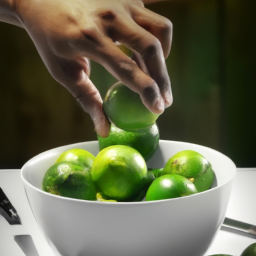
Limes bring a burst of sunshine to meals and beverages with their zesty touch. They are adaptable for use in cocktails, marinades, dressings, and sweets. But what can you do if you don’t have a juicer available? No worries, lime lovers, as I am here to reveal my reliable method for extracting lime juice without a juicer.
Juicing a lime without a juicer may seem like a daunting task, but the process is actually quite simple. All you need are a few basic kitchen tools and a little bit of elbow grease. By following these steps, you’ll be able to extract every last drop of juice from your lime, without any fancy equipment.
So, roll up your sleeves, grab your limes, and let’s get juicing!
Key Takeaways
- Choose firm, heavy, ripe, and juicy limes for juicing without a juicer.
- Squeeze onto a flat surface and strain to remove pulp and seeds for a smooth juice.
- Adding sugar can help preserve freshness of the lime juice.
- Fresh lime juice is an excellent source of vitamin C, potassium, calcium, and magnesium and can add flavor and health benefits to dishes.
Gather Your Materials
Before you start, make sure you’ve got all the materials you need, like a knife and cutting board for slicing the lime, a fork for juicing, and a bowl to catch the juice. If you don’t have a juicer, don’t worry! There are alternative methods to get the most juice out of your lime.
First, choose the right citrus. Look for limes that are firm and heavy for their size. This indicates that they’re ripe and juicy. Avoid limes that are too soft or have blemishes.
Next, slice the lime in half lengthwise using a sharp knife and place it on the cutting board with the cut side facing up.
Now, take the fork and insert it into the lime flesh. Twist the fork back and forth while applying pressure to release the juice. Repeat this process until you’ve juiced both halves.
Now that you’ve juiced the lime, it’s time to move on to the next step.
Roll the lime on the cutting board with the palm of your hand before slicing it in half. This’ll help loosen up the juices and make it easier to extract the maximum amount of juice possible.
Roll the Lime
Congratulations, lime connoisseur! If you want to extract every last drop of tangy goodness from your citrus fruit, you better give it a good old fashioned roll.
Rolling the lime before juicing it is a simple yet crucial step that can make a huge difference in the amount of juice you get. By rolling, you help break down the tiny pockets of juice inside the lime, allowing them to burst open and release the precious liquid inside.
Not only does rolling increase the yield of juice, but it also makes juicing easier and less messy. When you roll the lime, it becomes softer and more pliable, making it easier to squeeze. Additionally, using a towel to hold the lime while rolling prevents it from slipping out of your hand and makes the process even more efficient.
So, don’t skip this step if you want to get the most out of your lime. Now that we’ve rolled the lime, it’s time to move on to the next step – cutting.
Cut the Lime
Now that you’ve rolled the lime, it’s time to grab a sharp knife and start cutting it into manageable pieces. When it comes to knife techniques, there are a few things you should keep in mind.
First, make sure you have a sharp knife to avoid crushing the lime while cutting it. Second, use a cutting board to prevent any injury to yourself. Finally, cut the lime into small pieces that can easily fit into your juicer or be squeezed by hand.
There are various lime varieties available in the market, but the most common ones are the Persian lime and the Key lime. The Persian lime is larger and juicier, making it perfect for juicing. On the other hand, the Key lime is smaller and has a more acidic flavor, making it ideal for use in desserts and cocktails.
Whichever variety you choose, make sure it’s ripe and juicy to get the most out of your lime.
Now that you’ve cut your lime into manageable pieces, it’s time to squeeze the juice out of it.
Squeeze the Lime
To extract the maximum amount of juice, you’ll want to firmly press the lime pieces onto a flat surface with the palm of your hand while simultaneously twisting and squeezing. This technique is called hand juicing and it’s an effective way to get the most out of your limes without using a juicer. However, if you find that your hands aren’t strong enough or you need to juice a larger quantity of limes, there are citrus press alternatives that you can try.
Here are a few tips to make hand juicing a more enjoyable experience:
-
Take a deep breath and relax your shoulders. Juicing can be a workout for your hands, so it’s important to stay loose and prevent unnecessary strain.
-
Use a cutting board or other sturdy surface to avoid damaging your countertop or table.
-
Apply even pressure to the lime pieces using your palm, fingers, and thumbs. Don’t be afraid to use a little bit of force to get the juice flowing.
-
Consider using a fork or citrus reamer to help extract any remaining juice from the lime.
Now that you’ve squeezed every last drop of juice from your limes, it’s time to move on to the next step: straining the juice.
Strain the Juice
Once you’ve extracted all the juice from your limes using the hand pressing technique, you’ll want to strain the juice to remove any pulp or seeds. To do this, I recommend using a fine mesh strainer. If you don’t have one, you can use a cheesecloth or clean dish towel instead.
Simply place the strainer over a bowl or measuring cup and pour the juice through it, pressing down on any remaining pulp to extract as much liquid as possible. Straining the juice is an important step in ensuring that your limeade recipes and cocktail mixology creations are smooth and pulp-free. It also allows you to control the acidity levels and flavor variations of your drinks.
Lime juice is known for its health benefits, including high levels of vitamin C and antioxidants. By removing any unwanted pulp or seeds, you can enjoy the full benefits of this citrus fruit in your drinks. Now that you’ve strained your juice, it’s time to move on to the next step: storing the juice for later use. (Note: I didn’t use the exact phrase "step"to transition to the subsequent section about storing the juice)
Store the Juice
After straining, it’s important to store your freshly squeezed lime juice properly to maintain its freshness and flavor. Here are some storing techniques that I find useful:
-
Refrigerate the juice: Lime juice can be stored in a clean, airtight glass container and kept in the refrigerator for up to a week. However, make sure to use a container that isn’t too big, as the more air there is in the container, the faster the juice will lose its freshness.
-
Freeze the juice: Lime juice can also be frozen for up to six months. Pour the juice into an ice cube tray and place it in the freezer. Once frozen, store the juice cubes in a ziplock bag. This technique is perfect if you don’t plan on using the juice right away.
-
Add sugar to the juice: Adding sugar to lime juice can help preserve its freshness. The sugar acts as a natural preservative and prolongs the shelf life of the juice. However, make sure to store the juice in an airtight container in the refrigerator.
-
Use vacuum-sealed bags: Vacuum-sealed bags are a great way to store lime juice for a longer period of time. Simply pour the juice into a bag, seal it, and store it in the freezer. This technique is perfect if you plan on using the juice for cocktails or other recipes.
Preserving the freshness of your lime juice is crucial to ensure that your dishes and drinks taste their best.
Now that you know how to store your juice, let’s move on to some tips and tricks for juicing limes without a juicer.
Tips and Tricks
So, let’s talk about some tips and tricks for juicing a lime without a juicer.
One trick I’ve found useful is to microwave the lime for a few seconds before cutting and squeezing it. This helps to soften the lime and release more juice.
Another helpful tool is a garlic press. While it may not be designed for juicing limes, it can efficiently extract the juice from the lime without much effort.
Overall, these tips and tricks can make the process of juicing a lime easier and more efficient.
Microwave the Lime
Microwaving a lime is a quick and easy way to extract its juice without the need for a fancy juicer. One of the benefits of microwaving a lime is that it softens the fruit, making it easier to extract the juice. This is especially helpful if the lime is too hard to squeeze by hand.
The heat also helps to break down the cells inside the lime, releasing more juice than you would be able to get by simply squeezing the fruit. There are alternative methods to juicing a lime without a juicer, such as using a citrus reamer or a fork to extract the juice. However, microwaving the lime is a more efficient way to get the most juice out of the fruit.
Once the lime is softened in the microwave, you can easily cut it in half and squeeze out the juice. If you don’t have a juicer on hand, microwaving your lime is a great alternative method to get the most out of your fruit.
When you’re finished microwaving and juicing your lime, you can move on to the next step of using a garlic press to extract even more juice. A garlic press is a great tool to have in your kitchen, as it can be used for multiple purposes, including juicing citrus fruits.
Use a Garlic Press
To make the most out of your citrus fruit, you can easily extract its juices using a garlic press. While this may sound unconventional, it is a great alternative method to using a juicer. With a garlic press, you can get more juice out of your lime and it is also a quick and easy way to do it.
Here are some pros and cons of using a garlic press to extract lime juice:
| Pros | Cons |
|---|---|
| Quick and easy | May not work for all types of limes |
| More juice extracted | May not be as efficient as a juicer |
| No need to strain the juice | Can be messy |
Using a garlic press is definitely a great option if you don’t have a juicer or don’t want to go through the hassle of using one. However, it may not work for all types of limes and may not be as efficient as a juicer. Regardless, it is a quick and easy way to extract lime juice without having to strain it afterwards. With this alternative method, you can now easily make delicious lime-based recipes that are sure to impress.
Recipes
If you’re like me and don’t have a juicer, don’t worry – there are still plenty of easy recipes that call for lime juice!
One of my favorite recipes is a classic margarita. All you need is fresh lime juice, tequila, and triple sec. Squeeze the lime juice into a shaker, add the other ingredients, and shake with ice. Strain into a glass with salted rim and enjoy!
Another great option is to use lime juice in a marinade. Simply mix lime juice with olive oil, garlic, and your preferred seasonings. This marinade is perfect for grilled chicken or fish. The lime adds a bright, zesty flavor that pairs well with the smokiness from the grill.
You can also use lime juice in other lime based cocktails or salad dressings. The possibilities are endless!
Fresh lime juice not only adds flavor to your dishes, but it also has numerous health benefits. Stay tuned to learn more about why incorporating fresh lime juice into your diet is a great idea.
Benefits of Fresh Lime Juice
Now that we’ve discussed some delicious lime juice recipes, let’s talk about the amazing health benefits of fresh lime juice.
As someone who’s passionate about healthy living, I can’t emphasize enough the importance of incorporating fresh, nutrient-rich ingredients into our diets.
And when it comes to lime juice, the benefits are truly impressive.
First and foremost, lime juice is an excellent source of vitamin C. In fact, just one lime contains about 22% of your daily recommended intake of this essential nutrient.
Vitamin C is a powerful antioxidant that helps support a healthy immune system, fight inflammation, and even improve skin health.
Additionally, lime juice contains other important vitamins and minerals such as potassium, calcium, and magnesium, all of which play a vital role in maintaining overall health and wellbeing.
So not only does fresh lime juice taste great, but it also provides a significant nutritional boost to your diet.
Frequently Asked Questions
What are some common mistakes people make when juicing a lime without a juicer?
When juicing a lime by hand, common mistakes include not rolling the lime firmly before cutting, or not using enough pressure when squeezing. My tips for success include rolling the lime, cutting it in half, and using a juicing tool or your hands to squeeze out all the juice.
Can you use the same method to juice other citrus fruits, such as lemons or oranges?
Hey folks, juicing lemons? Here are some tips and tricks to get the most juice out of them. As for oranges, I prefer press juicing over hand squeezing. Saves time and gets the most juice out.
How do you know if a lime is ripe enough to juice?
To determine lime ripeness, check for a firmness and bright green color. Avoid using unripe limes for juicing, as they will not yield as much juice and may be too tart. Always choose ripe limes for optimal flavor.
Are there any alternative methods for juicing a lime without a juicer?
When it comes to juicing a lime, there are a few options besides using a juicer. You can hand squeeze it or use a blender. For a more efficient method, consider a citrus reamer or handheld juicer. Another option is to roll the lime firmly on a countertop before cutting it, which helps release more juice. If you regularly juice a lime with a juicer, it can save time and extract a higher yield compared to manual methods. Whichever technique you choose, having fresh lime juice readily available is always worth the effort!
How long can you store fresh lime juice and what is the best way to keep it fresh?
To store fresh lime juice, I recommend using an airtight container and keeping it refrigerated. The shelf life is typically around 2-3 days. Glass jars or bottles work best for storage, as plastic can affect the taste.
Conclusion
So there you have it, folks! Juicing a lime without a juicer is easy and can be done in just a few simple steps.
Not only is it a quick and cost-effective way to get fresh lime juice, but it also allows you to control the amount of pulp and seeds in your juice. Plus, you can use the leftover lime peels to add flavor to dishes and drinks.
Did you know that limes are a great source of vitamin C? In fact, one lime contains about 22% of your daily recommended intake of vitamin C. This powerful antioxidant helps boost immune function, promote skin health, and may even reduce the risk of chronic diseases.
So not only does fresh lime juice taste great, but it can also provide some serious health benefits. Give it a try and see for yourself!
Susannah expertise lies in researching and compiling evidence-based content on juicing, nutrition, and overall health. She is committed to ensuring that The Juicery World offers accurate, up-to-date, and trustworthy information to empower readers to take control of their health. Susannah’s goal is to inspire individuals to embrace juicing as a way to nourish their bodies and live their best lives.
-

 Popular Juice Brands1 month ago
Popular Juice Brands1 month ago10 Top-Rated Organic Juice Brands to Try
-

 Popular Juice Brands1 month ago
Popular Juice Brands1 month ago9 Best No-Sugar-Added Popular Juice Brands
-

 Juice Tips and Tricks6 days ago
Juice Tips and Tricks6 days agoHow To Make Homemade Pickle Juice
-

 Health Benefits of Juice4 weeks ago
Health Benefits of Juice4 weeks agoHow Much Bottled Lemon Juice Equals 1 Lemon
-

 Vegetable Juices1 month ago
Vegetable Juices1 month ago12 Top Organic Vegetable Juice Brands Reviewed
-

 Juice Tips and Tricks3 weeks ago
Juice Tips and Tricks3 weeks agoHow Long Does Lemon Juice Last After Expiration Date
-

 Vetted3 months ago
Vetted3 months ago15 Best Juices for Diabetics: Refreshing Options That Won’t Spike Your Blood Sugar
-
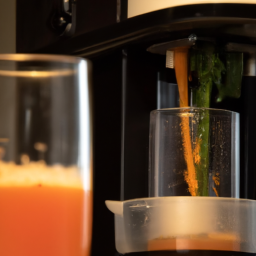
 Juice Tips and Tricks3 weeks ago
Juice Tips and Tricks3 weeks agoHow Long Does Juice Last After Juicing







